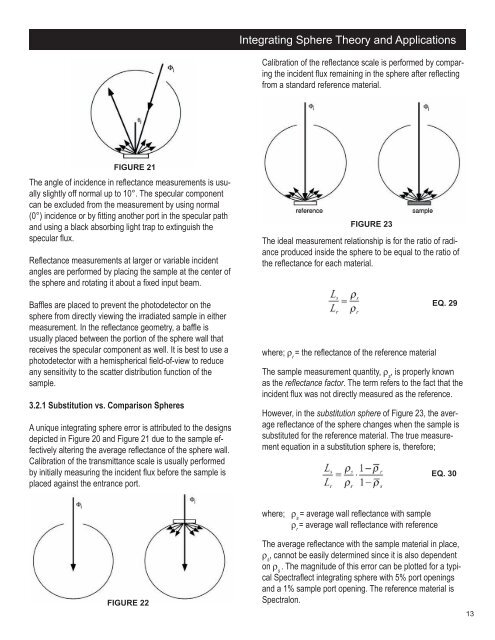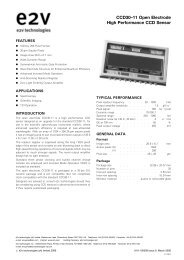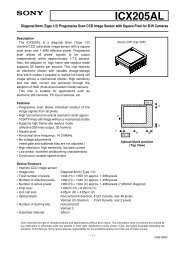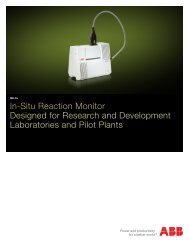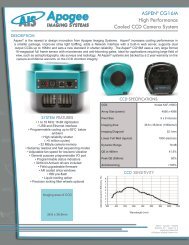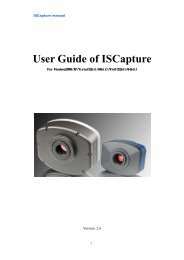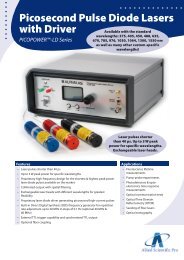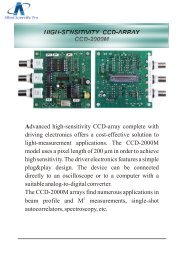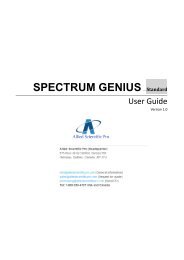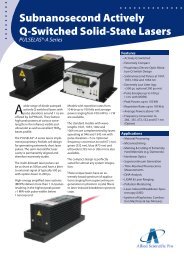Integrating Spheres theory and applications - Allied Scientific Pro
Integrating Spheres theory and applications - Allied Scientific Pro
Integrating Spheres theory and applications - Allied Scientific Pro
Create successful ePaper yourself
Turn your PDF publications into a flip-book with our unique Google optimized e-Paper software.
<strong>Integrating</strong> Sphere Theory <strong>and</strong> ApplicationsCalibration of the reflectance scale is performed by comparingthe incident flux remaining in the sphere after reflectingfrom a st<strong>and</strong>ard reference material.FIGURE 21The angle of incidence in reflectance measurements is usuallyslightly off normal up to 10°. The specular componentcan be excluded from the measurement by using normal(0°) incidence or by fitting another port in the specular path<strong>and</strong> using a black absorbing light trap to extinguish thespecular flux.Reflectance measurements at larger or variable incidentangles are performed by placing the sample at the center ofthe sphere <strong>and</strong> rotating it about a fixed input beam.Baffles are placed to prevent the photodetector on thesphere from directly viewing the irradiated sample in eithermeasurement. In the reflectance geometry, a baffle isusually placed between the portion of the sphere wall thatreceives the specular component as well. It is best to use aphotodetector with a hemispherical field-of-view to reduceany sensitivity to the scatter distribution function of thesample.3.2.1 Substitution vs. Comparison <strong>Spheres</strong>A unique integrating sphere error is attributed to the designsdepicted in Figure 20 <strong>and</strong> Figure 21 due to the sample effectivelyaltering the average reflectance of the sphere wall.Calibration of the transmittance scale is usually performedby initially measuring the incident flux before the sample isplaced against the entrance port.FIGURE 23The ideal measurement relationship is for the ratio of radianceproduced inside the sphere to be equal to the ratio ofthe reflectance for each material.where; r r= the reflectance of the reference materialEQ. 29The sample measurement quantity, r s, is properly knownas the reflectance factor. The term refers to the fact that theincident flux was not directly measured as the reference.However, in the substitution sphere of Figure 23, the averagereflectance of the sphere changes when the sample issubstituted for the reference material. The true measurementequation in a substitution sphere is, therefore;EQ. 30where; r s= average wall reflectance with sampler r= average wall reflectance with referenceFIGURE 22The average reflectance with the sample material in place,r s, cannot be easily determined since it is also dependenton r s. The magnitude of this error can be plotted for a typicalSpectraflect integrating sphere with 5% port openings<strong>and</strong> a 1% sample port opening. The reference material isSpectralon.13


